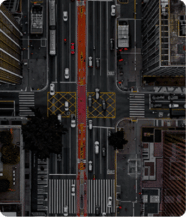
Blog
How Much New Risk Can Insurance Customers and Insurers Take?
Today’s insurance customer is under pressure and assault from every angle:
- Cyber criminals are using data breaches to access bank accounts and credit.
- Climate risk is growing, and a greater number of Cat events are threatening people and their property.
- Unsafe driving, inflation, and auto repair costs are responsible, in part, for rising premiums.
- Early onset cancer (affecting people in their 20s, 30s, and 40s) is on the rise, especially in women, who are 82% more likely than men to get early onset cancer — up from 51% in 2002.
- The socio-political climate is viewed as unstable, which can affect everything from inflation to investments, including the growth and sustainability of retirement savings.
Last month’s California wildfires, of course, solidify the case very well. It isn’t just the fact that there were wildfires, or that they were necessarily severe…it was also their unexpectedness. No one could predict such massive devastation in such a short period of time. At this moment, with 150,000 people displaced and property insurers scrambling to help customers, it’s clear that everyone in the industry needs to pull together to create new solutions to new levels of risk.
In Majesco’s recent Thought Leadership report, 8 Trends Shaping the Future of Insurance in 2025, we look at several trends with great relevance to insurance resiliency and risk management. In today’s blog, we’ll briefly look at these trends and discuss how insurers can begin to look at modern risk management as an opportunity to make changes they have probably been needing and wanting to make all along.
Trend: The new era of risk demands new technology
NAMIC, Moody’s, The Institutes, and others are all talking about the new era of risk. What does it mean?
Risk is growing, shifting, and becoming more complex. It does not operate in isolation. From health to property, risks are intensified against the backdrop of macroeconomic challenges. Predictability is gone. Risk events are more frequent. There are more combined risks. New layers of risk add new considerations and complexity.
From 1980 to 2022, the annual number of billion-dollar disasters, adjusted for inflation, averaged 8.1. Over the past five years, the U.S. has averaged 18 billion-dollar disasters a year.[i] The National Centers for Environmental Information has kept track of billion-dollar natural disasters since 1980 and cites increased exposure, vulnerability, and climate change as the reasons for the increase.
In the recent California wildfires, we once again saw combined areas of risk. First, there were multiple fires — and each fire affected the others, splitting fire crews and diminishing the ability to contain them. Of course, the fires were adversely affected by winds. No one doubts that no matter how the fires started, it was the winds that fueled the substantial devastation.
People lost property, homes and businesses. Some lost their lives. Many lost jobs. They lost their schools. Los Angeles and the state of California will lose tax revenue — an economic blow. It isn’t stating too much to think that Los Angeles will never be the same.
How do people, companies, and governments become better equipped with resilience to avoid catastrophic loss and ensure economic and personal safety? Technology must contribute to risk resiliency.
Unfortunately, little progress has been made to risk-resilient business models due to the operational challenges of cat events and increasing claims. Our short-term response is raising the cost of insurance. This is unsustainable for customers and the industry. We can see how insurance premiums are affecting the gulf coast and now, California. How much more risk can populations take before they are pushed toward the safest geographies?
How much more risk can insurers take before they simply cannot cover regions with the highest risk?
A need for a prevention-first mindset
We need to change our legacy business methods and technologies for assessing and managing risks, because they no longer work. With risk resilience, there must first be a focus on assessment and recommendations for prevention as a part of providing protection. Risk resilient business processes and technologies assess, communicate, educate, and recommend prevention and mitigation strategies to all customers, regardless of insurance type.
It requires new thinking, new technology, data sources, and analytics to adapt business models and navigate this new era of risk. Insurance customers and society depend on insurance to adapt.
This new era of risk must focus on proactive risk assessment, prevention, and mitigation by leveraging data, advanced analytics, and technology along with customer communication and engagement to follow through on recommendations, to drive profitability and customer loyalty.
Trend: The rise of climate risk technologies
Adapting to climate change – where predictable climate, risk, and weather conditions are no longer a given – starts with understanding, assessing, and managing climate risks.
In a report by the World Economic Forum, Innovation and Adaptation in the Climate Crisis: Technology for the New Normal, they assessed four data-driven and digital technologies for climate risk including risk analytics, climate-proofing supply chains, risk event responses, and R&D investment in new technologies.[ii]
Adapting and creating new AI models that leverage new data sources, and the power of advanced analytics is crucial to stay ahead and address climate risk.
Many of these new data types will be provided by new (and improved) sensors.
Some of the examples highlighted in the report mentioned include adding sea surface temperature data into ocean models that can be leveraged for hurricane assessments, using data from smart cities like smart sewer systems that avert flooding during heavy rainfall, and developing drought-resistant crops.
IoT technologies are increasingly being used beyond auto and property for other purposes such as tracking changes in air quality, temperature, and detection of wildfires to help provide alerts for health and safety reasons. Ag tech is also getting into leveraging data to manage agricultural risk, helping to measure weather, rain, and production.
Banking is in the early stages of determining how they will measure the impact of climate change on their financing portfolios – the homes and businesses that have loans. It is likely that most banks are underestimating their exposure to climate-related risk, just like many property insurers have underestimated their risk exposure.
The convergence of insurance and banking around climate risk and the impact to property and businesses will drive a new view and focus on risk assessment.
A great example of this is how we need to rethink loss control for property. Today, loss control is primarily used for high-value or high-risk properties, leaving a large portion of insurers’ portfolios untouched due to the cost, heavily focused on “boots on the ground.” Instead, by leveraging technology with self-surveys and videos with advanced analytics to assess the risk, insurers can segment and assess their entire property portfolio cost effectively, either in-person or digitally.
With these assessments, insurers can use the information to identify what customers can do to proactively reduce or eliminate risk, while helping to reduce cost. This builds an avenue for regular communication to enhance trust and loyalty. Improved communication between insurers and insureds needs to happen quickly, so both parties can be on the same “preventive” page and customers will take a greater interest and role in their protection.
For climate risk that insurers have less influence over, like climate change, insurers must seek out new technologies and strategies to ensure more profitable and equitable coverage.
Trend: Market Shifts Fuel New Product Growth Opportunities
New insurance products have the power to protect customers in new ways, while we are all experiencing changing risks. Here are three areas that will see heightened interest and demand by customers to meet their changing needs and expectations.
1. Protection as a Service
Majesco’s 2024 Consumer Research, pointed out that products based on usage-leveraging technologies such as wearables, telematics, or other sensors are growing and will continue to grow. The result is protection as a service based on usage – across both P&C and L&AH, including Gig worker-based usage.
We are seeing this play out in the popularity of usage-based, telematics-based auto products. (According to J.D. Power, participation rates have more than doubled since 2016, from 8% to 17%.)[iii] Interestingly, new customers are participating at a rate of 26%, reflecting the demand for this product and the risk for those who do not offer it.
As insurance costs continue to rise, interest and demand in these products will too – shifting DWP between carriers who offer them and those who do not.
2. Specialty Insurance
Specialty insurance is tailored to meet unique or niche risks that typically are unavailable or unaffordable within traditional, standard P&C products. Given the increased risk environment as well as increased pricing for traditional products, we are seeing a new “golden age” for specialty insurance. The global specialty insurance market was valued at $104.7 billion in 2021 and is projected to reach $279 billion by 2031 — a CAGR of 10.6% during this 10-year period.[iv]
The surge in demand will take advantage of technology advancements for pricing, rating, underwriting, and core by leveraging native Cloud, new data sources, APIs, document ingestion, AI and GenAI to elevate the automation and decisioning for specialty insurance.
3. Parametric Products
In addition to traditional weather-related risks, parametric insurance is expanding into new markets, including cyber risk, supply chain disruption, and pandemics as well as traditional areas such as earthquake, travel, fire, and more. There is an increasing recognition of the need to cover some aspects of risks when comprehensive coverage may not be financially viable.
Next-gen technology is foundational for parametric insurance, including cloud-native solutions, data and analytics in real-time, advanced risk models, and transparent and rapid policy management and claims payouts. These products are focused on providing more cost-effective risk coverage that customers need and can afford while helping to close the protection gap.
A variety of risks meet a variety of solutions
When we look at the complete picture of risk and the methods we can use to improve prevention and reduce risk, it is clear there is no one solution (technology or business model or new product) that makes an insurers and their insureds risk resilient — but it must be accomplished through a combination of changes, methods and technologies.
This must happen. Risk isn’t going away, in fact it is increasing, with no signs of abatement in the near future. If we want to wait and test just how much risk people and companies can take without change, we may come to the point where it is too late for us to adapt.
There were examples, in the California fires, of homes that didn’t burn. Their planning for prevention worked. They built with better materials. They installed mitigation systems. It is even likely in some cases that their insurers understood these efforts and lowered their premiums. No one method protected them, but all methods worked together to provide an enhanced level of protection.
Majesco is the kind of insurance partner that thinks in holistic terms and works on holistic solutions — applying the best technologies (such as Loss Control, Risk Analytics, AI Enterprise Rating, Intelligent Core for P&C, and Intelligent Core for L&AH)— to achieve the optimal results for insurers and those they cover. Find out how we can help you and your teams employ new technologies to improve the insurance experience, increase prevention, reduce claims, and save people and their property from undue risk.
To read about more insurance trends, be sure to download, 8 Trends Shaping the Future of Insurance in 2025, today.
[i] Rice, Doyle, “’Sobering’ data shows US set record for natural disasters, climate catastrophes in 2023,” USA Today, September 11, 2023, https://www.usatoday.com/story/news/nation/2023/09/11/us-sets-record-weather-climate-disasters-2023/70822661007/
[ii] “Innovation and Adaptation in the Climate Crisis: Technology for the New Normal,” World Economic Forum and Boston Consulting Group, January 2024
[iii] Crane, Grace, “Telematics and usage-based insurance on the rise: J.D. Power,” Digital Insurance, August 30, 2023, https://www.dig-in.com/news/telematics-and-usage-based-insurance-on-the-rise-j-d-power
[iv] “Specialty Insurance Market Positioned for Growth with a Predicted 10.6% CAGR by 2031 | Chubb, Tokio Marine HCC,” Insurance Newsnet, June 24, 2024, https://insurancenewsnet.com/oarticle/specialty-insurance-market-positioned-for-growth-with-a-predicted-10-6-cagr-by-2031-chubb-tokio-marine-hcc



